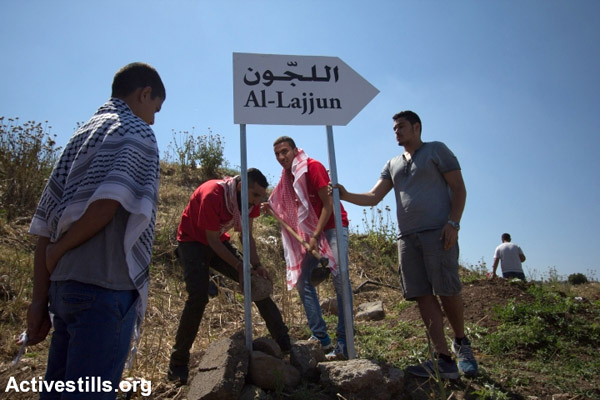Putting up signs marking destroyed Palestinian towns and villages could bring about a more moral discourse about the Nakba and its victims.
By Eitan Bronstein Aparicio

About two weeks ago, far from the public eye, something with potentially far-reaching and serious consequences occurred in Israel: An inspector on a local planning committee recommended that a sign be placed at a site slated for development in the city of Ashkelon, mentioning the Palestinian town of Hamama that stood there until 1948.
The inspector’s recommendation came in response to an objection to the development submitted by De-Colonizer, a research and art laboratory for social change based in Israel, as part of a public campaign that has been joined by hundreds of people in Israel and around the world.
In his recommendation the inspector wrote: “A museum will, if it is built, note the site’s Canaanite, Philistine, Phoenician, Hellenic, Roman, Byzantine, Arab and Crusader heritage, and/or a sign will be put up mentioning the town of Hamama next to the vegetation from that time: cactuses, and so on.”
This is a significant leap forward. Until now not a single member of Israel’s planning establishment has ever officially suggested commemorating a Palestinian town destroyed by Israel during the Nakba. Proposals to put up such signs come from outside the establishment, generally as a way to criticize the powers that be.
Such suggestions and activities are generally viewed as provocation. Hundreds of unofficial signs put up by groups such as Zochrot, which seeks to bring awareness of the Nakba and Palestinian refugees to the Israeli public, were taken down a short time after appearing.
The idea of putting up signs in recognition of Nakba villages and towns was originally developed by Zochrot, along with a small group of Israelis who met in Tel Aviv in December 2001 to discuss the topic.
That discussion revolved around a text I had written, which included the following point: “Mentioning destroyed Palestinian villages through erecting signs marks another effort to bring civil and national equality in Israel. Physical signage of the villages and a public discussion about the Palestinian Nakba will encourage a more moral dialogue, in which the suffering of victims and the desecration caused will be recognized.
“This public recognition is an expression of a genuine desire for reconciliation. The visibility of the destroyed villages could move the Jewish public into a liberating process of confronting [this topic].”
The dialogue around the Nakba has indeed developed significantly since then, following diverse and intensive activities on the subject. But the the idea of putting up simple signs in order to note the former presence of these villages still arouses panic and automatic opposition in Israel.
It is interesting and saddening that despite the progress in the discussions surrounding the Nakba, one can still see with a naked eye the violence and racism that prevails in public discourse, the end of which is nowhere in sight.
The committee did not accept the full recommendation of the inspector. It removed the suggestion to put up a sign, just as regular Israelis do when these signs actually appear on the landscape.
The committee’s decision stated: “Should a museum be established, the committee recommends that it include the periods presented, documenting and referencing the village.”
Putting up signs such as these is essentially a colonial act that is a given for the sovereign power alone. Therefore, even signs referencing Israel’s Palestinian history remain incredibly challenging.
Following that same small meeting in 2001, Zochrot held its first tour on Land Day in 2002. The visit was to the village of Miska, and included putting up several memorial and informational signs. Since then dozens of such tours have taken place, in which thousands of Israelis have participated, including two just the last week to Abu Kabir and Hamama.
Even if these signs do not stay up for long, it is becoming clear that there are open ears within planning committees that are changing their language. The insistence on continuing to write in this de-colonized language seems like a frivolous dream given the current difficult reality. But without that dream we will have to put up with living by the sword. That, in itself, must rouse every human being.
Eitan Bronstein Aparicio is the founder of Zochrot and co-director of De-Colonizer.

